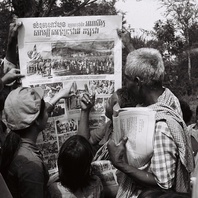
Featured Item
Villagers and soldiers pointing at poster
This (probably staged) photograph shows a group of villagers and soldiers reading an illustrated, A0-size propaganda poster celebrating the Kampuchea United Front for National Salvation (KUFNS, also known as FUNSK) [Front or Renakse]. The image provides a clear view of the poster and the photos on it. The poster’s title reads: “Fight for the Front” (or, more literally, “rush and struggle under the front’s flag”). The photos on the poster have captions in Khmer. One of the older villagers holds the upper right-hand corner of the poster. He has a folded poster in his other hand. Next to him, a young boy points his finger at the top picture, which shows the founding of the Kampuchea United Front for National Salvation in Kratie in December 1978. A female soldier points her finger at the caption below the picture. This photograph is part of the collection held by the Agence Khmère de Presse (AKP) and Cambodia’s Ministry of Information. This collection, which documents the early years of the People’s Republic of Kampuchea as photographed by the Vietnamese and a small team of Cambodian photographers, has not yet been classified or indexed.
Read More
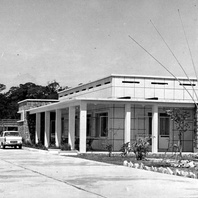
Featured Item
Motel in Sihanoukville
This modern-style motel pavilion is low, with two stone architectural elements and a seven-branch sculpture to the side. The photograph is part of the collection that was donated to the National Archives of Cambodia from the Library of the Royal University of Fine Arts by Darryl Collins and Helen Grant Ross in 2003. The collection was used by Collins and Ross for their research into urbanisation. The images were probably originally used to mount the Sangkum Reastr Niyum Permanent Exhibition at the Exhibition Hall, Bassac area, Phnom Penh. An image of the same pavilion was used to illustrate an article entitled “Discovering the Cambodian Riviera” in the monthly pictorial Kambuja no. 22 (January 1967): 44. The motel was described in that pictorial as “grand luxe” with a daily price of USD15.
Read More
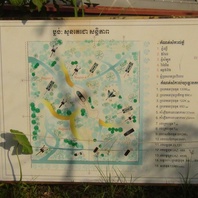
Item
Map of display of Soviet military equipment at Win-Win Monument
This photograph shows a map of the open-air display of Soviet military equipment that is located on the southern side of the Win-Win Monument complex. The Win-Win Monument complex – photographed here in January 2020 – was inaugurated in December 2018 to mark the twentieth anniversary of the end of the post-Democratic Kampuchea civil war, with the final defection of the remaining Khmer Rouge factions, thanks to the DIFID policy (“Divide, Isolate, Finish, Integrate, Develop”) also known as the “Win Win” policy of Prime Minister Hun Sen.
Read More
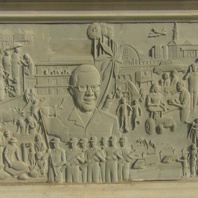
Item
Win-Win Monument bas-relief
This photograph provides a view of the bas-relief on the 117-metre-long engraved base of the Win-Win Monument. It depicts the rebirth of Cambodia after 1979 with different sectors being represented (religion, agriculture, transport, etc.). Hun Sen is featured in the middle, and is larger in sizes than other figures. The Win-Win Monument complex – photographed here in January 2020 – was inaugurated in December 2018 to mark the twentieth anniversary of the end of the post-Democratic Kampuchea civil war, with the final defection of the remaining Khmer Rouge factions, thanks to the DIFID policy (“Divide, Isolate, Finish, Integrate, Develop”) also known as the “Win Win” policy of Prime Minister Hun Sen.
Read More
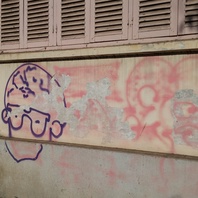
Case Study
Spatial Politics of Identity in Cambodia
Read More
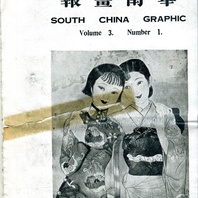
Item
Huanan huabao (South China Graphic) inside cover, January 1941
This image is taken from Huanan huabao (South China graphic) 3.1 (January 1941). The illustration deploys one of the standard tropes of Japanese propaganda in occupied China, i.e., that of a Japanese woman and Chinese woman fraternising with each other. This trope was derived from Manchukuo propaganda and the notion of “gozoku kyōwa” (“the harmony of the five races”), as well as attempts to feminise the image of an occupied China. Note how the Japanese woman is pictured as being slightly higher than her Chinese peer.
Read More
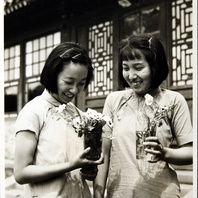
Item
Two girls picked flowers for the dinner table [sic]
From a collection of staged photographs produced under the title “Life at a Girls School in Peking”, and produced at the Peking Jiyu Gakuen in Japanese-occupied Beijing. The original caption reads: “Two girls picked flowers for the dinner table [sic]”.
Read More
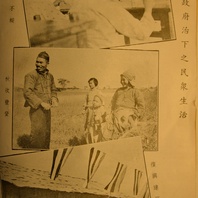
Item
Weixin zhengfu zhixia zhi minzhong shenghuo (The life of the masses under the Reformed Government)
This series of unattributed photographs is taken from the Daminhui publication Xin Zhongguo (New China) 3.1 (January 1940). They are used here to present scenes of life under the rule of the Reformed Government (Weixin zhengfu), or RGROC, which was a “client regime” established in 1938. The RGROC was eventually amalgamated with Wang Jingwei’s RNG in March 1940. The top image is entitled “xian’ge bu chuo” (“studying never stops, even in times of strife”); the middle image is entitled “qiu shou fengdeng” (gathering the autumn harvest); the image at the bottom of the page is entitled “fuxing jianzhu” (renovating buildings). All three are typical images of the sort that the Daminhui promoted in the period between 1938 and 1940, but also display a clear influence from Manchukuo propaganda photography from earlier in the 1930s.
Read More
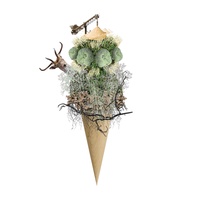
Essay
Bodies of Occupation: Conversation with the art collective Fraud
This conversation with Fraud will explore their work Carbon Derivatives, an art-led enquiry into forest and foreshores as salvage sites for carbon incorporating questions such as salvage accumulation, waste management, indentured labour and slavery. Carbon Derivatives (2018-ongoing), courtesy of the artists. Participants Ariadne Collins is a Lecturer at the School of International Relations at the University of St Andrews. Her work lies at the intersection of climate change governance, environmental policy and international development. More specifically, she analyses the interplay between market-based conservation and postcolonial development. Her work features an emphasis on processes of racialisation and histories of colonialism, and their challenge to the successful enactment of forest governance policies in the Global South. Ariadne was awarded a PhD (Summa cum laude) from Central European University in Budapest, Hungary, in May 2017. She holds a Masters in Research (Distinction) from the University of Westminster and a Bachelors from the University of Guyana. Prior to joining the University of St. Andrews, she was a Postdoctoral Research Fellow at the Institute for Cultural Inquiry in Berlin. She was also a visiting researcher at the Centre for Space, Place and Society at Wageningen University, the Netherlands. She has given talks on colonialism, environmental histories, raw material and climate change at exhibition spaces in Berlin and the United Kingdom (publications). FRAUD is made up of the duo Audrey Samson and Francisco Gallardo. Critical spatial practitioners, they develop modes of art-led enquiry, which examine the processes of financialisation through extractive practices, and cultivate critical cosmogony building. They are currently exploring the extractivist gaze of the Critical Raw Materials Initiative with their project EURO—VISION. Audrey (b. Canada) leads the Digital Arts Computing programme and is a Critical Studies Lecturer in the Art Department at Goldsmiths, University of London. Somerset House Studio alumni, the duo has been awarded the State of Lower Saxony – HBK Braunschweig Fellowship (2020), the King’s College Cultural Institute Grant (2018), and has been commissioned by the Contemporary Art Archipelago (2020) and the Cockayne Foundation (2018). Francisco (b. Spain) is an architect who completed a PhD in the School of Geography at Queen Mary, University of London, he was awarded the Wellcome Trust People Awards (2016) and authored Talking Dirty, published by Arts Catalyst (2016). FRAUD’s recent work includes: “Carbon Derivatives” that has been namely presented at the Salon Suisse (the 57th Venice Biennale), the Whitechapel Gallery (2018) and the Somerset House (2018); “Shrimping Under Working Conditions”, that was shown at Kunsthall Trondheim (2017) and the Empire Remains Shop in London (2016); and “Goodnight Sweetheart / the Right to Happiness” which was exhibited at Fotomuseum Winterthur (2020-21), the Asia Culture Center in Gwangju (2019), and has been featured in “Behind the Smart World”, Radio Canada, and Asia Art Pacific. The duo’s work is part of the permanent collections of the European Investment Bank Institute (LU) and the Art and Nature Center – Beulas Foundation (SP) (their website and see also). Theo Reeves-Evison is a Leverhulme Early Career Fellow at Birmingham School of Art, where his research focuses on the critical imbrications of art, ecology and speculation. He is the editor (with Jon K. Shaw) of Fiction as Method (Sternberg, 2017), and has published recent articles in journals such as Parallax, New Formations and Critical Inquiry. In 2018 he edited a special issue of the journal Third Text with Mark Rainey on the theme of “ethico-aesthetic repairs”. His monograph Ethics of Contemporary Art: In The Shadow of Transgression was recently published by Bloomsbury Academic (his website).
Read More
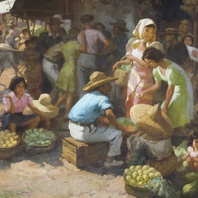
Page
About the COTCA Project
How has foreign occupation shaped culture? What has been the lasting cultural legacy of foreign occupation in those societies where it represented a common state of affairs for much of the modern era? The Cultures of Occupation in Twentieth Century Asia (COTCA) Project (an ERC-funded project under the European Union’s Horizon 2020 Research and Innovation Programme: Grant Number 682081) will address these questions by analysing how occupation – be it under colonial, wartime or Cold War powers – gave rise to unique visual, auditory and spatial regimes in East and Southeast Asia in the modern era. COTCA’s three streams The COTCA Project is run along three interconnected streams: Representations of occupation Sounds of occupation Spaces of occupation The objectives of Stream 1 (Representations of Occupation) are to: provide a comprehensive understanding of the ways in which occupation was represented by those who experienced it in twentieth-century Asia trace how the experience of occupation led to the development of specific visual cultures in East and/or Southeast Asia. In other words, what did occupation look like? The objectives of Stream 2 (Sounds of Occupation) are to: understand how individuals or groups who operated under occupation developed new forms of auditory expression which justified their responses to occupation explain how the experience of foreign occupation led to specific auditory cultures and soundscapes which were unique to such a context. In other words, what did occupation sound like? The objectives of Stream 3 (Spaces of Occupation) are to: determine how occupation gave rise to new forms of cultural expression in the spatial realm (eg. manipulation of the natural and built environment for cultural purposes; the re-ordering of existing spaces or architectural forms in the occupation context, etc.) trace how cultural representations, and interpretations of space and landscape, were altered by occupation. In other words, what was the shape of occupation? COTCA activities The COTCA Project hosts regular external speakers at the University of Nottingham, while COTCA team members also present their work regularly at conferences and workshops, and publish work developed under the Project. You can learn more about COTCA-related events by following us on our web site, on Facebook and on Twitter (#COTCAProject).
Read More
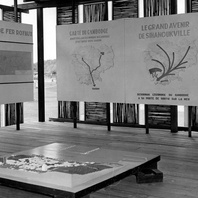
Featured Item
Sangkum Reastr Niyum Exhibition, Sihanoukville
This photograph shows maps and models on display at the Sangkum Reastr Niyum exhibition in Sihanoukville. The exhibition is displayed on a wooden platform in a room structured by half open bamboo walls. There are two maps of Cambodia on the right-hand side. The first map, with arrows from two directions pointing to Saigon, reads: “Avant 1955 [date of the construction of Sihanoukville] l’axe économique du Cambodge était dirigé vers Saigon” [Before 1955, the economic axis of Cambodia was oriented to Saigon]. The second map, with thicker arrows pointing from different directions to Sihanoukville reads: “Désormais, l’économie du Cambodge a sa porte de sortie sur la mer” [Now, Cambodia’s economy has its own sea access]. The title of the map is: “Le grand avenir de Sihanoukville” [The great future of Sihanoukville]. The photograph is part of the collection that was donated to the National Archives of Cambodia from the Library of the Royal University of Fine Arts by Darryl Collins and Helen Grant Ross in 2003. The collection was used by Collins and Ross for their research into urbanisation. The images were probably originally used to mount the Sangkum Reastr Niyum Permanent Exhibition at the Exhibition Hall, Bassac area, Phnom Penh.
Read More
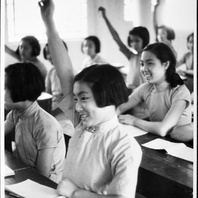
Page
Using Search
Search using keywords The COTCA Digital Archive can be searched using keywords which will search all content on the site. Advanced search terms can be used in any keyword search. On search results pages you can refine results using filters. Search using filters Search results can be narrowed down using filters. You can refine by result “type” and narrow down your results using filters. Adding many filters all at one time may give you 0 results, so it may be best to add filters a few at a time. Keyword searches can be used alongside facets to further refine your results. Saving your search All searches can be bookmarked using your browser, or you can copy the URL for the search and use the URL to see the same search results at a later date. Advanced searching The search on COTCA uses Lucene Search. Here are some of the common ways to use the advanced features of Lucene search. Common Lucene syntax And AND, && or + For example: China && Women will search for items containing both “China” and “Women”. Or OR or || For example: China OR Women will search for documents containing either “China” or “Women” or both. Because OR is the default conjunction operator, you could also leave it out, such that China Women is the equivalent of China OR Women. Not NOT, ! or – The NOT operator is an exclamation point or the minus sign. For example: China!Women will search for documents that have the “China” term and/or do not have “Women”. Exact phrase “” Using “” around words will search for the exact set of words in the same order in documents. For example “Women China” would return documents containing those exact words in that order. Wild card * Find documents containing the words with the prefix “note”, such as “notebook” or “notepad”, specify “note*” Fuzzy search ~ Use the tilde “~” symbol at the end of a single word with an optional parameter, a number between 0 and 2 (default), that specifies the edit distance. For example, “blue~” or “blue~1” would return “blue”, “blues”, and “glue”.